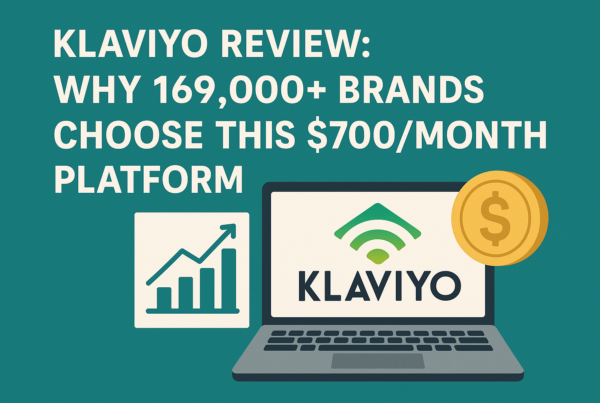Is Squarespace really as sleek and beginner-friendly as they claim? Squarespace reviews often highlight its stunning visuals, but there’s more beneath the surface worth exploring. With over 180 aesthetically pleasing templates designed for various industries, Squarespace makes a strong first impression. However, when billed annually, pricing ranges from $16 to $99 per month, making you wonder, Is Squarespace worth it?
In this review, we’ll examine Squarespace based on real usage and feature testing, comparing it to alternatives so you can make an informed decision. Additionally, we’ll dive into Squarespace for blogging capabilities, evaluate its new course creation features, and provide a balanced look at Squarespace’s pros and cons.
Despite its impressive AI tools and integrated analytics showing hourly, daily, and monthly traffic statistics, Squarespace’s 1.2 out of 5 stars on Trustpilot raises questions about customer service quality, which is a factor for those asking, “Is Squarespace good for beginners?”. Whether you’re a creative professional, small business owner, or content creator, this comprehensive analysis will help determine if this popular website builder aligns with your specific needs in 2025.
What Is Squarespace and Who Is It Best For?

Squarespace reviews often highlight its comprehensive nature as a content management system, bringing essential tools together. As Higo Creative notes, “Founded in 2003, this platform has evolved into more than just a website builder; it’s a complete ecosystem for online presence.”
1. All-in-one platform: Hosting, design, and commerce
Unlike fragmented solutions requiring multiple subscriptions and integrations, Squarespace delivers a consolidated experience. You can create a website, host content, register a custom domain, sell products, and track analytics with a single subscription. This integration eliminates the technical headaches many face when piecing together various services.
The platform’s approach is notably streamlined; everything you need to build a functional and attractive website comes built in. From email marketing connections to video embeds and galleries, these tools are accessible without requiring additional plugins or complex setups. One user described Squarespace as “the apple of websites” due to its intuitive design and seamless functionality.
For business owners, Squarespace offers:
- Straightforward payment and checkout options, including Klarna, ACH, Apple Pay, and major credit cards
- Mobile-optimized websites that provide seamless experiences across devices
- Built-in SEO tools to improve search visibility
- Inventory management and product organization features
2. Ideal users: Creatives, small businesses, and beginners
While Squarespace serves various users, statistics reveal its core audience. According to Higo Creative, 66% of Squarespace users are small businesses, demonstrating its appeal to this demographic. Moreover, 9% of users are large businesses with revenues exceeding $1000 million, showing their scalability for growing operations.
The platform particularly shines in the following areas:
- Beginners and non-technical users: With its intuitive drag-and-drop builder and customizable templates, Squarespace makes website creation accessible without coding knowledge.
- Creative professionals: Originally designed for creatives and service-based companies, it offers visually striking templates ideal for portfolios, photography sites, and design showcases.
- Small to medium businesses: The platform includes robust eCommerce features like inventory management and mobile-optimized checkout.
Globally, Squarespace’s appeal transcends borders, with a presence in more than 200 countries and territories. This widespread adoption highlights its versatility across different markets and cultures.
3. What is Squarespace used for in 2025?
In 2025, Squarespace will have expanded beyond basic website building to support diverse business needs. The platform now powers 314,000 active online stores and boasts over 4.9 million unique subscriptions.
Currently, businesses use Squarespace for:
- Selling versatile products: Beyond physical goods, the platform supports subscriptions, digital downloads, services, and membership content.
- Course creation: Member Areas enable selling memberships for private content, including classes, courses, and paid newsletters.
- Scheduling and booking: Service-based businesses can accept appointments and manage calendars through integrated tools.
- Podcast hosting: Complete podcasting support, which includes audio blocks and setup for Apple Podcasts.
- AI-enhanced content: Recent developments include AI tools for content creation and personalized brand voice.
Furthermore, Squarespace has maintained relevance through continuous evolution, with recent updates including scheduled invoicing and email automation features. This commitment to innovation ensures the platform remains competitive in the ever-changing digital landscape of 2025.
Want to explore more options? Check out our detailed guide on Best Website Builders for Creators, packed with insights for designers, photographers, and entrepreneurs.
Hands-On Review: Using Squarespace in 2025
After spending considerable time building and testing various websites, my hands-on experience with Squarespace reviews in 2025 reveals impressive strengths and notable limitations worth considering before committing to this platform.
1. Design & Templates: 180+ options with modern esthetics ★★★★★
According to Squarespace, “Squarespace continues to excel in the visual department with over 180 professionally designed templates that immediately set your site apart.” In 2025, the platform introduced several noteworthy design trends, including “Organic Matter” featuring earthy palettes, “Visual Smiles” with playful elements, and “Vivid Glow” that breaks away from minimalist approaches with bold colors and patterns.
The platform’s new Blueprint AI feature effectively streamlines the design process by suggesting curated color schemes and font combinations tailored to your brand vision. Consequently, you can create a distinct aesthetic without needing design expertise.
Although visually stunning, some templates can be restrictive regarding customization. As one user noted, “Perfect for my photography portfolio, but I had trouble integrating custom scripts.” This assessment accurately captures Squarespace’s design philosophy, which is polished but somewhat confined.
2. Ease of Use: Drag-and-drop builder with grid layout ★★★★☆
Squarespace has significantly improved its user experience with the Fluid Engine editor, representing a major upgrade from its Classic Editor. As Taryn Mercedes highlights, “Unlike the previous system’s 12-column grid, Fluid Engine operates on a 24-column grid that allows for precise placement and manipulation of elements.”
Key improvements include:
- Independent mobile editing, allowing separate desktop and mobile designs
- Ability to layer elements without custom code
- Option to move multiple blocks simultaneously by holding the shift key
- Full edge-to-edge placement capability
Initially, there’s a learning curve, especially for those familiar with the Classic Editor. Nevertheless, once mastered, the system proves remarkably intuitive. The ability to edit mobile layouts separately addresses a long-standing limitation, as previously, mobile responsiveness couldn’t be fully customized.
3. Website Speed & SEO: Performance and limitations ★★★☆☆
Regarding performance, Squarespace offers impressively fast load times compared to competitors, yet PageSpeed scores tell a different story. The platform’s reliance on JavaScript and CSS for design functionality sometimes interferes with crawling and indexing.
For SEO, Squarespace provides essential tools like customizable page titles, meta descriptions, and an SEO checklist to guide optimization efforts. Moreover, the platform supports basic structured data through JSON-LD, which enhances search listings with rich snippets.
Despite these advantages, several limitations exist:
- Limited access to the underlying code restricts advanced SEO customizations
- No control over server location, affecting international audiences
- Fewer advanced SEO plugins compared to WordPress
- The heading structure is often tied to design elements, making proper hierarchy difficult
4. Squarespace for eCommerce ★★★★☆
Squarespace reviews in 2025 often highlight its streamlined selling experience for small to medium online stores. The platform supports versatile product types, including physical goods, digital downloads, services, and subscriptions.
The inventory management system is exceptionally user-friendly; you can quickly update stock levels, prices, and product information from a centralized dashboard. Furthermore, the checkout process has been optimized for 2025 with added payment options including PayPal, Stripe, Square, and Afterpay.
Recent updates have introduced features like anchor links for improved navigation and expanded Squarespace Payments availability to Ireland and France. These enhancements and comprehensive analytics for tracking sales performance make Squarespace a compelling option for businesses with moderate eCommerce needs.
Overall, Squarespace in 2025 delivers a balanced combination of aesthetic appeal, usability, and functionality, though with some trade-offs that we’ll explore further when comparing it to alternatives.
Squarespace for Blogging and Content Creators

Content creators often prioritize different features than general website builders, making blogging functionality a critical factor when evaluating Squarespace. For writers and bloggers, Squarespace offers a unique combination of visual appeal and functional limitations worth exploring.
1. Editor experience for writers and bloggers
First and foremost, Squarespace reviews often mention that its blogging interface operates entirely through a block-based system. As you write, you’ll add text blocks, image blocks, video blocks, and other content elements sequentially. This approach provides a clean organization but can feel restrictive compared to more fluid editors.
The platform offers an intuitive design similar to editing regular pages on your website. Indeed, you can incorporate the same design elements, spacers, lines, images, and graphics into your blog posts that you use elsewhere on your site. This consistency creates a seamless visual experience that many competitors lack.
Granted, this block-based approach has drawbacks. Once your post grows longer with numerous blocks, the editor can experience performance issues. Some users report visual glitches, browser freezing, and even losing unsaved changes when working with lengthy posts. What works beautifully for simple splash pages becomes cumbersome for serious content creators.
2. Markdown support and SEO settings
As Squarespace notes, “For technically inclined writers, Squarespace provides Markdown blocks, a convenient way to add content using basic HTML.” This feature supports most fundamental Markdown syntax elements, including headings, paragraphs, bold, italic, blockquotes, lists, code blocks, and tables. You can write pure HTML using these blocks, giving you additional flexibility without switching to code view.
As a result, developers and technical writers gain valuable formatting options, though the tiny editing box with a non-adjustable font size frustrates many users.
SEO settings in Squarespace make optimization straightforward for bloggers. At the bottom of each post editor, you’ll find dedicated fields for:
- Meta descriptions (150-160 characters recommended)
- SEO titles (50-60 characters recommended)
- URL slugs (short, keyword-friendly formats suggested)
Beyond these basics, Squarespace makes connecting to Google Search Console effortless, allowing you to track keywords and post performance without complex integrations.
3. Squarespace for blogging review: Pros and cons
When considering “Is Squarespace worth the price?”, it excels in certain blogging aspects while falling short in others.
Strengths:
- Clean, professional visual presentation
- Seamless integration with your overall site design
- Solid on-page SEO capabilities for ranking in search results
- Unlimited storage and bandwidth, even on basic plans
Limitations:
- No dedicated table of contents feature (requires manual HTML creation)
- Browser performance issues with longer, complex posts
- Lack of a blogging API for external editing tools
- Empty lines from other editors (like Google Docs) create formatting inconsistencies.
For Squarespace for blogging review, content creators often find it represents a compromise, trading some advanced blogging functionality for visual consistency and ease of setup. The platform works exceptionally well for visual blogs with moderate posting frequency, but may frustrate high-volume content creators seeking more specialized tools.
Curious about the cost? Read our full breakdown on Squarespace Pricing Explained: Is It Worth It? over Medium, where we cover every plan, hidden fees, and what you get for your money.
Squarespace Courses Review: Can You Teach Online?
Since August 2023, Squarespace has offered a dedicated course-building feature, allowing creators to teach online directly from their websites. This addition expands Squarespace’s functionality beyond traditional website building into the growing online education market.
1. Course builder and sales page setup
Squarespace courses reviews often highlight that setting them up follows a straightforward process, aligning with the platform’s design-first approach. You start by adding a Course page to your website and selecting a layout that matches your vision. From there, you organize your content into chapters and lessons, each customizable using the same drag-and-drop Fluid Engine editor you use throughout your site..
The course structure supports multiple content formats, including videos, images, text, audio, and downloadable materials. At the same time, you can create customized sales pages that showcase your course offerings before purchase. This unified approach keeps everything on-brand without requiring third-party integrations.
2. Strengths: Seamless design and checkout
Squarespace Courses shines primarily in these areas:
- Complete design control: Unlike platforms like Teachable, where customization is limited, Squarespace gives you full control over how your lesson pages look and function
- Integrated commerce: Courses work with Squarespace’s existing payment systems, allowing you to offer one-time payments or subscription access with various pricing models
- Brand consistency: Your courses maintain the same visual identity as your website, creating a cohesive experience for students
Additionally, the platform lets you track student progress through lessons and chapters, making navigation intuitive for learners who can easily pick up where they left off.
3. Limitations: No marketplace, fewer features than Teachable
Regardless of its strengths, Squarespace Courses lacks several features of dedicated learning platforms. The most notable limitations include:
No built-in community tools for student discussions or forums, requiring third-party solutions. Unlike specialized platforms, Squarespace doesn’t offer content dripping based on different cohorts or quizzes to test comprehension. As Squarespace Help Center notes, “You can add up to 250 lessons per course page.” This limitation might be problematic for very comprehensive educational offerings.
The platform also lacks marketing tools common to education-focused competitors; no affiliate program, upsells, or order bumps exist to help promote your courses. The absence of student progress monitoring beyond basic analytics presents another challenge for serious educators.
Ultimately, Squarespace course reviews suggest it works best for creators already invested in the platform who want to offer educational content without managing multiple systems. However, Squarespace course reviews often point out that dedicated platforms like Teachable remain more suitable for those prioritizing advanced course features over design.
Squarespace vs Alternatives: When It Might Not Be Right for You
While Squarespace provides an excellent all-in-one solution for many users, several alternatives offer distinct advantages depending on your specific needs. Understanding these differences helps determine when Squarespace might not be your ideal platform.
1. Wix: More flexible but less polished design
For those who find Squarespace’s template structure too limiting, Wix offers greater design flexibility. With over 900 templates (compared to Squarespace’s 180+) and deep customization options, Wix provides a more free-flowing design experience. The unstructured editor allows you to place elements anywhere on the page rather than conforming to Squarespace’s grid system.
Wix also boasts more robust AI tools, having developed them earlier than Squarespace. Nevertheless, this flexibility comes at the cost of less polished overall aesthetics. One reviewer noted that “Wix-powered sites have more variety,” but often lack the refined visual cohesion that defines Squarespace.
2. Webflow: Better for designers/devs, steeper learning curve
Webflow represents the professional designer’s alternative to Squarespace. Unlike Squarespace’s simplicity-first approach, Webflow offers “maximum customization potential without needing to write a single line of code.” Its interface resembles professional design applications, making designers who use Adobe products feel at home.
Beyond design flexibility, Webflow provides more comprehensive integration options with over 180 apps compared to Squarespace’s 40+ native integrations. Furthermore, Webflow excels in team collaboration with separate design and edit modes that allow multiple people to work simultaneously without conflicts.
The downside? Webflow has an “overwhelming interface” for beginners. Even with simplification efforts, it remains “suited for professional users, while Squarespace is meant for everyone.”
3. WordPress: Open source, best for blogging or scaling
WordPress began as a blogging platform and has evolved into a comprehensive content management system with remarkable flexibility. Unlike Squarespace’s closed ecosystem, WordPress provides an open-source framework where “if there’s a feature that you want, there’s a 99.9% chance a plugin exists for it.”
This platform excels for content-intensive sites, offering “a robust blogging system with extensive tools for content creation, community engagement, analytics, and more.” However, WordPress requires separate hosting and domain registration, plus potentially significant costs for premium plugins and themes.
The WordPress learning curve proves steeper than Squarespace, reflecting a common trade-off: “Simple software is easy to use. Powerful software usually has a steeper learning curve.”
4. Shopify: Stronger for advanced eCommerce
For serious online sellers, Shopify provides specialized eCommerce capabilities beyond Squarespace’s offerings. Shopify “shines in areas that make clear that it was built by people who know what it takes to do eCommerce.”
Key advantages include native multi-channel selling across platforms like Facebook, Instagram, TikTok, Amazon, and Walmart without additional integrations. Shopify also supports numerous payment gateways, offers comprehensive shipping integrations with major carriers, and provides better point-of-sale options for online and offline businesses.
The platform’s extensive app ecosystem delivers thousands of specialized tools compared to Squarespace’s more limited extensions. Therefore, “it’s primarily those aiming to scale an eCommerce business who will lean heavily on Shopify’s additional features.”
5. Teachable/Kajabi: Better for online courses
While Squarespace now offers course functionality, dedicated platforms like Teachable and Kajabi provide significantly more robust educational tools. Unlike Squarespace’s basic course structure, these platforms provide features like student progress tracking, quizzes, and automated certificates of completion.
Teachable particularly shines with its affiliate system, allowing course creators to create personalized affiliate links. Both platforms offer content dripping capabilities to release lessons according to schedules and more sophisticated student engagement tools.
From a pricing perspective, the Teachable Professional plan runs $99 per month with no transaction fees. At the same time, Kajabi ranges from $149 to $399 monthly, reflecting its specialized nature as a complete course delivery system rather than a website builder with course functionality.
Squarespace Pros and Cons (Summary Table)
Squarespace presents a user-friendly platform with visually appealing templates and an all-in-one setup, making it ideal for beginners and personal brands. However, its limited customization, less robust SEO, and higher cost for advanced e-commerce or large-scale sites are key drawbacks.
| Pros | Details | Cons | Details |
| Beautiful templates | Over 180 professionally designed, visually appealing templates offer a polished and modern aesthetic right out of the box. | Limited customization | Less flexibility in design compared to platforms like WordPress or Webflow; fewer options for deep code-level modifications. |
| Easy for beginners | Intuitive drag-and-drop interface, streamlined content management, and helpful built-in guidance make it accessible for non-technical users. | Not ideal for large blogs/stores | It can become less efficient for managing a vast amount of content or a very extensive product catalog compared to dedicated platforms. |
| All-in-one setup | Hosting, security, and software updates are all managed by Squarespace, simplifying website maintenance and reducing the need for external services. | SEO features could be better | While it offers basic SEO tools, it lacks the advanced customization and plugin ecosystem of platforms like WordPress for more granular optimization. |
| Good for personal brands/portfolios | Visually focused design and integrated marketing tools are well-suited for showcasing creative work and building a strong online presence. | Expensive for advanced features | Higher-tier plans with advanced e-commerce functionalities and marketing tools can be pricier than comparable offerings from competitors. |
| Reliable performance & security | Benefit from Squarespace’s robust infrastructure, ensuring good uptime and built-in SSL security for your website. | Fewer third-party integrations/plugins | Smaller app marketplace compared to WordPress or Shopify, limiting the availability of specialized third-party tools and integrations. |
| Integrated e-commerce tools | Offers built-in features for selling products, subscriptions, and digital goods, simplifying the setup of an online store. | Transaction fees on lower-tier plans | Personal and some Business plans include transaction fees on sales, which can impact profitability for sellers with higher volumes. |
| Strong customer support | Provides helpful documentation and responsive customer support channels to assist users with issues or questions. | Less control over data ownership | As a hosted platform, you have less direct control over your website’s underlying data than self-hosted options. |
| Built-in marketing tools | Email marketing campaigns, social media integrations, and basic analytics are included to help promote your website and track performance. | Design lock-in | Switching to a different platform later can be more challenging due to the proprietary nature of Squarespace’s system and templates. |
Evaluating Squarespace’s pros and cons reveals a strong platform for aesthetically focused individuals and small businesses seeking simplicity. However, its limitations in customization and scalability should be considered against its premium pricing.
Squarespace Reviews: What real users are saying
Squarespace receives praise for its beautiful templates and ease of use, making it popular among creatives and small businesses. However, users often mention frustrations with limited customization and customer support. Reviews are notably mixed, reflecting both satisfaction and disappointment.
1. Trustpilot Reviews
Trustpilot Squarespace reviews are mostly negative, with a low average rating (around 1.4–1.5 stars). Many users complain about poor customer support, restrictive customization, and issues with domain management. Here are some real examples:
(i) Somnur van der Kraan: Rating: 5/5
“I especially wanted to write because I don’t understand why there is negative feedback written about Squarespace. Competitor firms are probably submitting negative feedback about Squarespace. I used a very famous name’s web page builder for a long time. Despite being a big name, it was slow and never adjusted properly for mobile phones. An error would always occur shortly after publishing the page. Now I am very happy with Squarespace. It is fast, easy, and everything is created properly. I am also happy because it has advanced design settings. Thanks, Squarespace.”
(ii) Andrzej: Rating: 3/5
“It’s confusing how domains are managed between Google and Squarespace. There are Google Domains and Google Cloud Domains. Google Domains are fully managed by Squarespace (DNS settings, etc), and Google Cloud Domains are only registered with Squarespace but managed through Google Cloud. A customer service agent clarified it for me.”
You can read more reviews on the Squarespace Trustpilot page.
2. Reddit Reviews
On Reddit, feedback is more balanced, with users sharing positive and negative experiences. Here’s a look at what users are saying:
(i) u/webdevbeginner: Rating: 4/5
“I’ve always found it easy to use both for my site and when we went to launch our business. We built the initial no-code version on Squarespace, the current marketing site, and some brand sites as examples. None of them were visually focused brands. Setting up membership sections and even embedding Stripe for payments is easy. It’s also easy enough to use Mailchimp as an embedded newsletter tool.”
(ii) u/ahmetaltunw: Rating: 2/5
“The problem with platforms like Squarespace is that they own your website. You can’t migrate it elsewhere if you want to switch hosts (due to cost, tech support, performance, etc.). While you own the content you upload, the theme and underlying code are owned by Squarespace. WordPress, on the other hand, can be hosted by numerous low-cost, high-performance hosts. It’s popular because it works and is relatively easy to use. Although it may not be as simple as a drag-and-drop solution, tools like Elementor make it almost as easy. In short, if you want a site where you can update yourself, go with WordPress.”
You can find these discussions on the Squarespace Reddit review thread.
3. Capterra Reviews
Capterra Squarespace reviews highlight Squarespace’s user-friendly interface and professional designs, but some users express concerns about pricing and limited third-party integrations. Here are two real user reviews:
(i) Jessica M.: Rating: 4/5
“Squarespace made launching my business site simple, but I wish there were more plugins and a cheaper starter plan. The templates and design options are great, but the limited integrations with third-party apps can be frustrating.”
(ii) Tom R.: Rating: 3/5
“While Squarespace’s platform is easy to use and visually appealing, the pricing is higher for the offered features. The customization options are okay for basic users, but not enough for more complex needs. I’ve also had a couple of issues with the integration of email marketing tools.
You can read more reviews on the Squarespace Capterra review page.
Final Verdict: Is Squarespace Right for You?

After thoroughly examining Squarespace’s features, capabilities, and limitations in 2025, one conclusion stands clear, as reflected in numerous Squarespace reviews: this platform excels for specific users while falling short for others. Squarespace delivers exceptional value for small businesses, creative professionals, and those prioritizing aesthetics without technical complexity. The stunning templates, intuitive Fluid Engine editor, and comprehensive all-in-one approach eliminate many headaches associated with website creation.
Nevertheless, Squarespace shows notable limitations when compared to specialized alternatives. WordPress offers superior blogging functionality and endless customization. Shopify provides more robust eCommerce features for scaling businesses. Teachable and Kajabi deliver more comprehensive course creation tools. Therefore, your choice ultimately depends on your specific priorities and long-term goals.
Squarespace makes the most sense if you value:
- Visual impact and professional aesthetics
- Streamlined management of website, domain, and hosting
- Simplified content creation without technical knowledge
- Moderate eCommerce needs within a single platform
Alternatively, you might want to explore other options if you require:
- Maximum customization flexibility
- Advanced blogging functionality
- Extensive course features with community tools
- Enterprise-level eCommerce capabilities
The platform’s recent improvements, including AI-enhanced design tools, Fluid Engine’s 24-column grid, and initial course creation features, demonstrate Squarespace’s commitment to evolution. Still, the rigid structure and limited advanced SEO options remain considerations, especially for content-heavy sites.
Before committing to any paid plan, you should take advantage of Squarespace’s 14-day free trial. This hands-on experience will help determine whether the platform’s unique combination of visual polish and functionality aligns with your specific website goals, allowing you to make a confident decision based on personal experience rather than reviews alone.
FAQs on Squarespace reviews
Q1: What are the primary features of Squarespace in 2025?
Squarespace in 2025 delivers an integrated platform encompassing website hosting and intuitive design tools. Users benefit from built-in commerce functionalities for online sales, email marketing capabilities, and seamless video embedding. Comprehensive analytics provide insights, complemented by over 180 professionally designed templates and effective SEO tools.
Q2: Who is Squarespace best suited for?
Squarespace’s user-friendly interface and visually appealing templates make it an excellent choice for individuals new to website creation. Creative professionals can showcase their portfolios beautifully, while small to medium-sized businesses can leverage their robust eCommerce features for online sales and growth. The platform balances simplicity with powerful functionality.
Q3: What are the strengths of Squarespace for blogging?
Squarespace provides a clean and visually focused presentation for blogging that enhances readability. Its seamless integration within the overall website ensures a cohesive user experience. Solid built-in SEO capabilities help content reach a wider audience, and even the basic plans offer unlimited storage and bandwidth for extensive content creation without worry.
Q4: What limitations does Squarespace have for advanced users?
Advanced users seeking granular control might find Squarespace’s customization options somewhat restrictive. The absence of advanced SEO plugins limits fine-tuning for search engine optimization. Furthermore, the lack of control over server location and the constraints on deep template customization can pose challenges for those with specific technical requirements.





